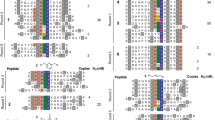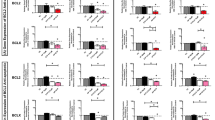Abstract
The anti-apoptotic molecule Aven was originally identified in a yeast two-hybrid screen for Bcl-xL-interacting proteins and has also been found to bind Apaf-1, thereby interfering with Apaf-1 self-association during apoptosome assembly. Aven is expressed in a wide variety of adult tissues and cell lines, and there is increasing evidence that its overexpression correlates with tumorigenesis, particularly in acute leukemias. The mechanism by which the anti-apoptotic activity of Aven is regulated remains poorly understood. Here we shed light on this issue by demonstrating that proteolytic removal of an inhibitory N-terminal Aven domain is necessary to activate the anti-apoptotic potential of the molecule. Furthermore, we identify Cathepsin D (CathD) as the protease responsible for Aven cleavage. On the basis of our results, we propose a model of Aven activation by which its N-terminal inhibitory domain is removed by CathD-mediated proteolysis, thereby unleashing its cytoprotective function.
Similar content being viewed by others
Log in or create a free account to read this content
Gain free access to this article, as well as selected content from this journal and more on nature.com
or
Abbreviations
- Ac-DEVD-AFC:
-
N-acetyl-Asp-Glu-Val-Asp-7-amino-4-trifluoromethylcoumarin
- Apaf-1:
-
apoptotic protease activating factor 1
- ATM:
-
ataxia telangiectasia mutated
- Bcl-xL:
-
B cell lymphoma extra large
- Bcl-2:
-
B-cell lymphoma 2
- Bid:
-
BH3 interacting domain death agonist
- CathD:
-
Cathepsin D
- CED-4:
-
cell death abnormality 4
- Cyt c:
-
cytochrome c
- dATP:
-
desoxy-adenosine-triphosphate
- DMEM:
-
Dulbecco's modified Eagle's medium
- DMSO:
-
dimethyl sulfoxide
- DTT:
-
dithiothreitol
- EDTA:
-
ethylenediaminetetraacetic acid
- E64:
-
N-[N-(L-3-trans-carboxyirane-2-carbonyl)-L-leucyl]-agmatine
- FasL:
-
Fas ligand
- FBS:
-
fetal bovine serum
- GFP:
-
green flourescent protein
- IP:
-
immunoprecipitation
- LAV:
-
large intracellular acidic vesicles
- MES:
-
2-(N-morpholino)ethanesulfonic acid
- NaCl:
-
sodium chloride
- NHS AcD3-acetate:
-
N-hydroxysuccinimide trideutero-acetate
- PEI:
-
polyethylenimine
- pAPMSF:
-
p-amidino-phenylmethylsulfonylfluoride
- ProT:
-
prothymosin alpha
- RPMI:
-
1640 Roswell Park Memorial Institute
- TNF:
-
tumor necrosis factor
- z-VAD:
-
carbobenzoxy-valyl-alanyl-aspartyl-[O-methyl]-luoromethylketone
References
Brenner D, Mak TW . Mitochondrial cell death effectors. Curr Opin Cell Biol 2009; 21: 871–877.
Ow YP, Green DR, Hao Z, Mak TW . Cytochrome c: functions beyond respiration. Nat Rev Mol Cell Biol 2008; 9: 532–542.
Bao Q, Shi Y . Apoptosome: a platform for the activation of initiator caspases. Cell Death Differ 2007; 14: 56–65.
Li P, Nijhawan D, Budihardjo I, Srinivasula SM, Ahmad M, Alnemri ES et al. Cytochrome c and dATP-dependent formation of Apaf-1/caspase-9 complex initiates an apoptotic protease cascade. Cell 1997; 91: 479–489.
D’Amelio M, Tino E, Cecconi F . The apoptosome: emerging insights and new potential targets for drug design. Pharm Res 2008; 25: 740–751.
Hajra KM, Liu JR . Apoptosome dysfunction in human cancer. Apoptosis 2004; 9: 691–704.
Ledgerwood EC, Morison IM . Targeting the apoptosome for cancer therapy. Clin Cancer Res 2009; 15: 420–424.
Jiang X, Kim HE, Shu H, Zhao Y, Zhang H, Kofron J et al. Distinctive roles of PHAP proteins and prothymosin-alpha in a death regulatory pathway. Science 2003; 299: 223–226.
Qi X, Wang L, Du F . Novel small molecules relieve prothymosin alpha-mediated inhibition of apoptosome formation by blocking its interaction with Apaf-1. Biochemistry 2010; 49: 1923–1930.
Beere HM, Wolf BB, Cain K, Mosser DD, Mahboubi A, Kuwana T et al. Heat-shock protein 70 inhibits apoptosis by preventing recruitment of procaspase-9 to the Apaf-1 apoptosome. Nat Cell Biol 2000; 2: 469–475.
Pandey P, Saleh A, Nakazawa A, Kumar S, Srinivasula SM, Kumar V et al. Negative regulation of cytochrome c-mediated oligomerization of Apaf-1 and activation of procaspase-9 by heat shock protein 90. EMBO J 2000; 19: 4310–4322.
Saleh A, Srinivasula SM, Balkir L, Robbins PD, Alnemri ES . Negative regulation of the Apaf-1 apoptosome by Hsp70. Nat Cell Biol 2000; 2: 476–483.
Chau BN, Cheng EH, Kerr DA, Hardwick JM . Aven, a novel inhibitor of caspase activation, binds Bcl-xL and Apaf-1. Mol Cell 2000; 6: 31–40.
Kutuk O, Temel SG, Tolunay S, Basaga H . Aven blocks DNA damage-induced apoptosis by stabilising Bcl-xL. Eur J Cancer 2010; 46: 2494–2505.
Choi J, Hwang YK, Sung KW, Kim DH, Yoo KH, Jung HL et al. Aven overexpression: association with poor prognosis in childhood acute lymphoblastic leukemia. Leuk Res 2006; 30: 1019–1025.
Paydas S, Tanriverdi K, Yavuz S, Disel U, Sahin B, Burgut R . Survivin and aven: two distinct antiapoptotic signals in acute leukemias. Ann Oncol 2003; 14: 1045–1050.
Brezniceanu ML, Volp K, Bosser S, Solbach C, Lichter P, Joos S et al. HMGB1 inhibits cell death in yeast and mammalian cells and is abundantly expressed in human breast carcinoma. FASEB J 2003; 17: 1295–1297.
Rabenhorst U, Beinoraviciute-Kellner R, Brezniceanu ML, Joos S, Devens F, Lichter P et al. Overexpression of the far upstream element binding protein 1 in hepatocellular carcinoma is required for tumor growth. Hepatology 2009; 50: 1121–1129.
Scaffidi C, Schmitz I, Zha J, Korsmeyer SJ, Krammer PH, Peter ME . Differential modulation of apoptosis sensitivity in CD95 type I and type II cells. J Biol Chem 1999; 274: 22532–22538.
Massard C, Zermati Y, Pauleau AL, Larochette N, Metivier D, Sabatier L et al. hTERT: a novel endogenous inhibitor of the mitochondrial cell death pathway. Oncogene 2006; 25: 4505–4514.
Seong GJ, Park C, Kim CY, Hong YJ, So HS, Kim SD et al. Mitomycin-C induces the apoptosis of human Tenon's capsule fibroblast by activation of c-Jun N-terminal kinase 1 and caspase-3 protease. Invest Ophthalmol Vis Sci 2005; 46: 3545–3552.
Gour-Salin BJ, Lachance P, Magny MC, Plouffe C, Menard R, Storer AC . E64 [trans-epoxysuccinyl-L-leucylamido-(4-guanidino)butane] analogues as inhibitors of cysteine proteinases: investigation of S2 subsite interactions. Biochem J 1994; 299 (Part 2): 389–392.
Vandenabeele P, Vanden Berghe T, Festjens N . Caspase inhibitors promote alternative cell death pathways. Sci STKE 2006; 2006: pe44.
Levy JH, Sypniewski E . Aprotinin: a pharmacologic overview. Orthopedics 2004; 27 (6 Suppl): s653–s658.
Laura R, Robison DJ, Bing DH . (p-Amidinophenyl)methanesulfonyl fluoride, an irreversible inhibitor of serine proteases. Biochemistry 1980; 19: 4859–4864.
Umezawa H, Aoyagi T, Morishima H, Matsuzaki M, Hamada M . Pepstatin, a new pepsin inhibitor produced by Actinomycetes. J Antibiot (Tokyo) 1970; 23: 259–262.
Liaudet-Coopman E, Beaujouin M, Derocq D, Garcia M, Glondu-Lassis M, Laurent-Matha V et al. Cathepsin D: newly discovered functions of a long-standing aspartic protease in cancer and apoptosis. Cancer Lett 2006; 237: 167–179.
Masson O, Bach AS, Derocq D, Prebois C, Laurent-Matha V, Pattingre S et al. Pathophysiological functions of cathepsin D: targeting its catalytic activity versus its protein binding activity? Biochimie 2010; 92: 1635–1643.
Garcia M, Platet N, Liaudet E, Laurent V, Derocq D, Brouillet JP et al. Biological and clinical significance of cathepsin D in breast cancer metastasis. Stem Cells 1996; 14: 642–650.
Janicke RU, Sprengart ML, Wati MR, Porter AG . Caspase-3 is required for DNA fragmentation and morphological changes associated with apoptosis. J Biol Chem 1998; 273: 9357–9360.
Impens F, Colaert N, Helsens K, Ghesquiere B, Timmerman E, De Bock PJ et al. A quantitative proteomics design for systematic identification of protease cleavage events. Mol Cell Proteomics 2010; 9: 2327–2333.
Montcourrier P, Mangeat PH, Salazar G, Morisset M, Sahuquet A, Rochefort H . Cathepsin D in breast cancer cells can digest extracellular matrix in large acidic vesicles. Cancer Res 1990; 50: 6045–6054.
Guo JY, Yamada A, Kajino T, Wu JQ, Tang W, Freel CD et al. Aven-dependent activation of ATM following DNA damage. Curr Biol 2008; 18: 933–942.
Ola MS, Nawaz M, Ahsan H . Role of Bcl-2 family proteins and caspases in the regulation of apoptosis. Mol Cell Biochem 2011; 351: 41–58.
Staes A, Impens F, Van Damme P, Ruttens B, Goethals M, Demol H et al. Selecting protein N-terminal peptides by combined fractional diagonal chromatography. Nat Protoc 2011; 6: 1130–1141.
Ghesquiere B, Colaert N, Helsens K, Dejager L, Vanhaute C, Verleysen K et al. In vitro and in vivo protein-bound tyrosine nitration characterized by diagonal chromatography. Mol Cell Proteomics 2009; 8: 2642–2652.
Theos AC, Berson JF, Theos SC, Herman KE, Harper DC, Tenza D et al. Dual loss of ER export and endocytic signals with altered melanosome morphology in the silver mutation of Pmel17. Mol Biol Cell 2006; 17: 3598–3612.
Acknowledgements
We thank R Jänicke (University of Düsseldorf, Germany), M Rimpler (MDC Berlin, Germany), GM Cohen (MRC Toxicology Unit, University of Leicester, UK), R Eskes (Molecular Hematology, University Clinic Frankfurt, Germany), and JM Hardwick (John Hopkins University, Baltimore, USA) for generously supplying the cells, expression constructs and antiserum (see Materials and Methods for details). FI is a Postdoctoral Fellow of the Research Foundation – Flanders (FWO-Vlaanderen). This work was supported by grants from the German Cancer Aid Foundation (no. 108659; MZ) and the German National Genome Research Network (NGFN project N1KR-S12T23, MZ). Furthermore, the financial support by the Ministerium für Innovation, Wissenschaft und Forschung des Landes Nordrhein-Westfalen is gratefully acknowledged. KG acknowledges support from a research project of the FWO-Vlaanderen (G.0048.08).
Author information
Authors and Affiliations
Corresponding author
Ethics declarations
Competing interests
The authors declare no conflict of interest.
Additional information
Edited by JM Hardwick
Supplementary Information accompanies the paper on Cell Death and Differentiation website
Supplementary information
Rights and permissions
About this article
Cite this article
Melzer, I., Fernández, S., Bösser, S. et al. The Apaf-1-binding protein Aven is cleaved by Cathepsin D to unleash its anti-apoptotic potential. Cell Death Differ 19, 1435–1445 (2012). https://doi.org/10.1038/cdd.2012.17
Received:
Revised:
Accepted:
Published:
Issue date:
DOI: https://doi.org/10.1038/cdd.2012.17
Keywords
This article is cited by
-
Down-regulation of miR-30b-5p protects cardiomyocytes against hypoxia-induced injury by targeting Aven
Cellular & Molecular Biology Letters (2019)
-
Forkhead-box transcription factor 1 affects the apoptosis of natural regulatory T cells by controlling Aven expression
BMC Immunology (2017)
-
Enzymatically active cathepsin D sensitizes breast carcinoma cells to TRAIL
Tumor Biology (2016)
-
MicroRNA miR-30 family regulates non-attachment growth of breast cancer cells
BMC Genomics (2013)
-
Aven is dynamically regulated during Xenopus oocyte maturation and is required for oocyte survival
Cell Death & Disease (2013)



